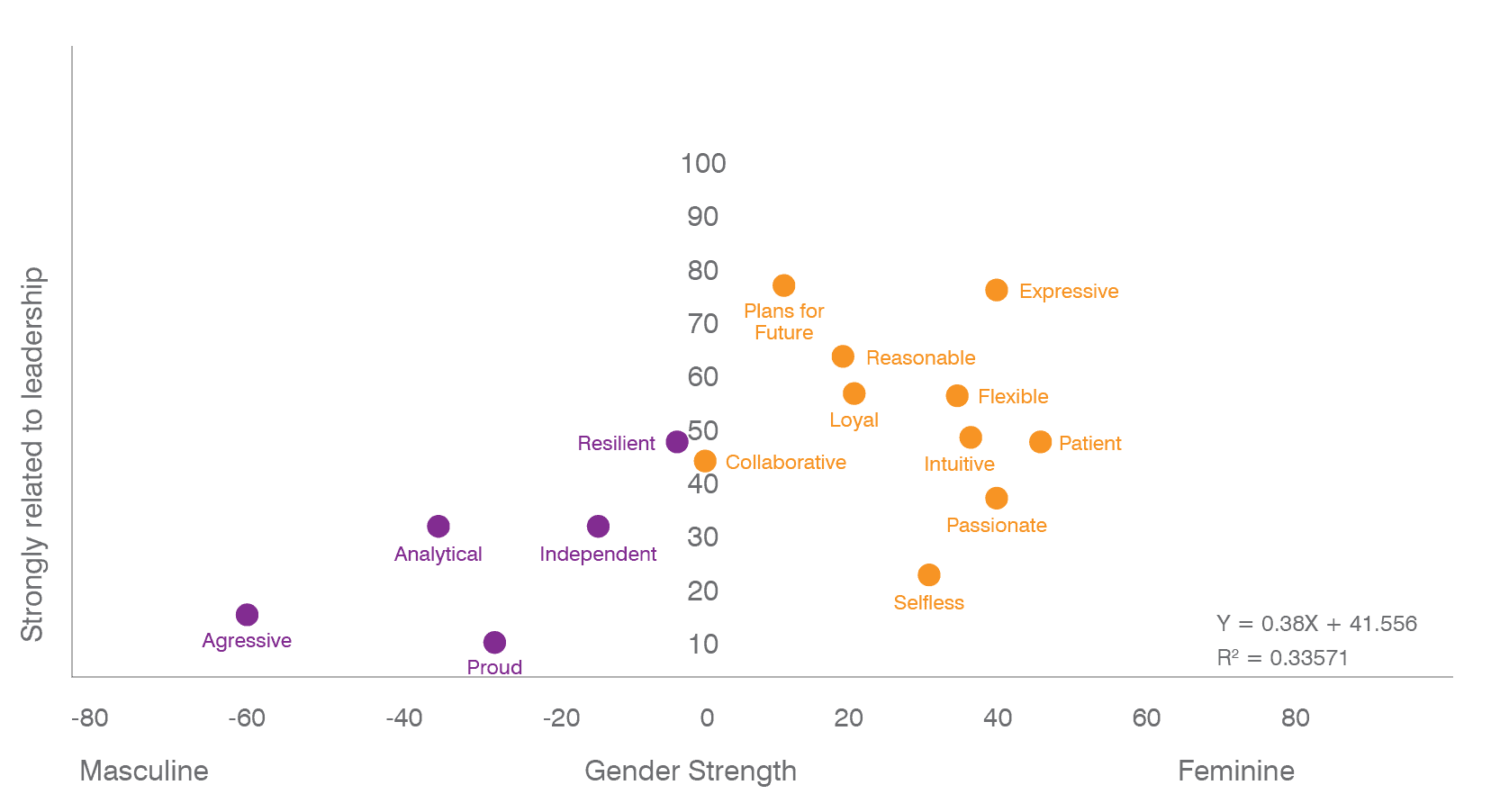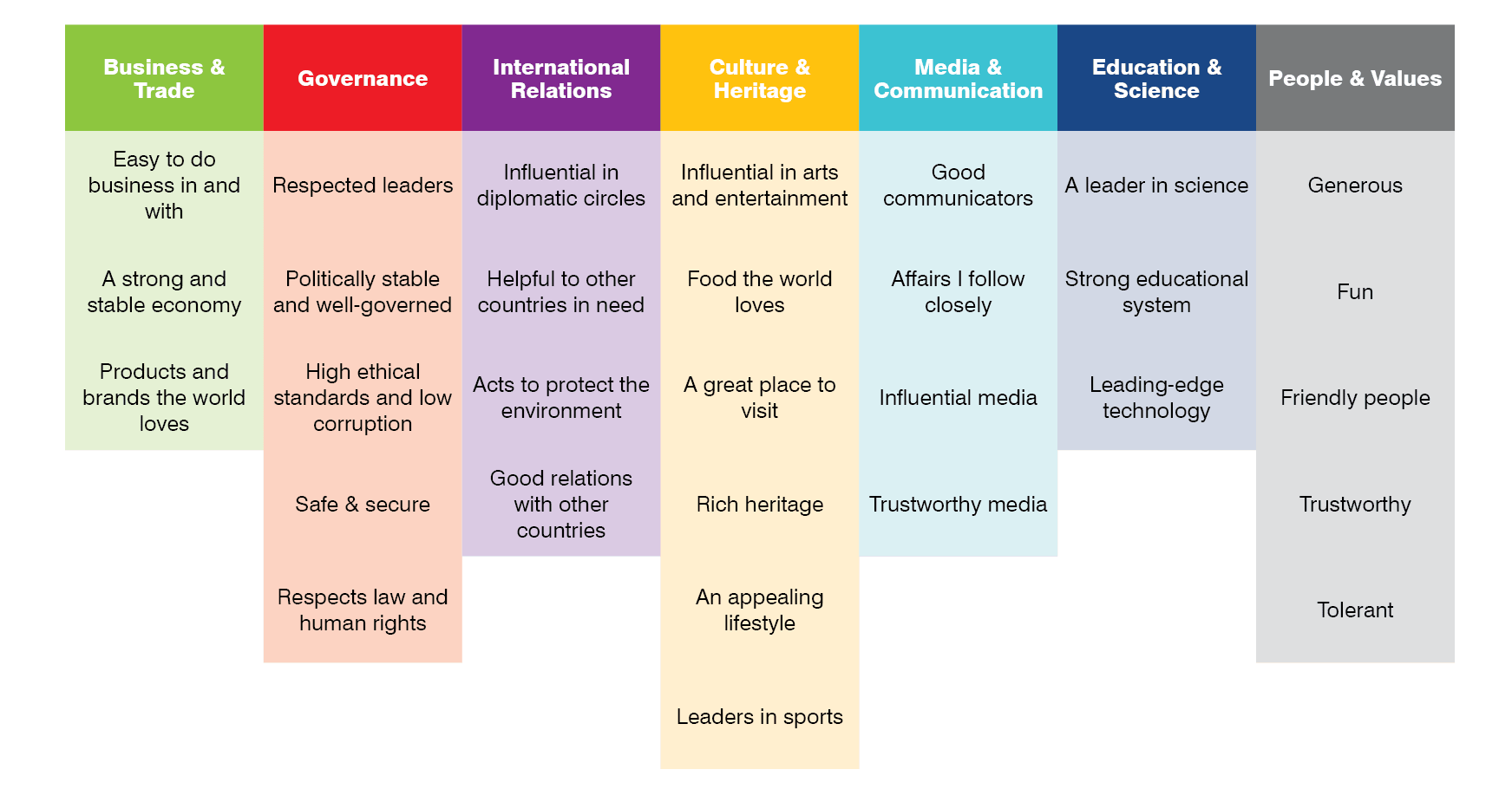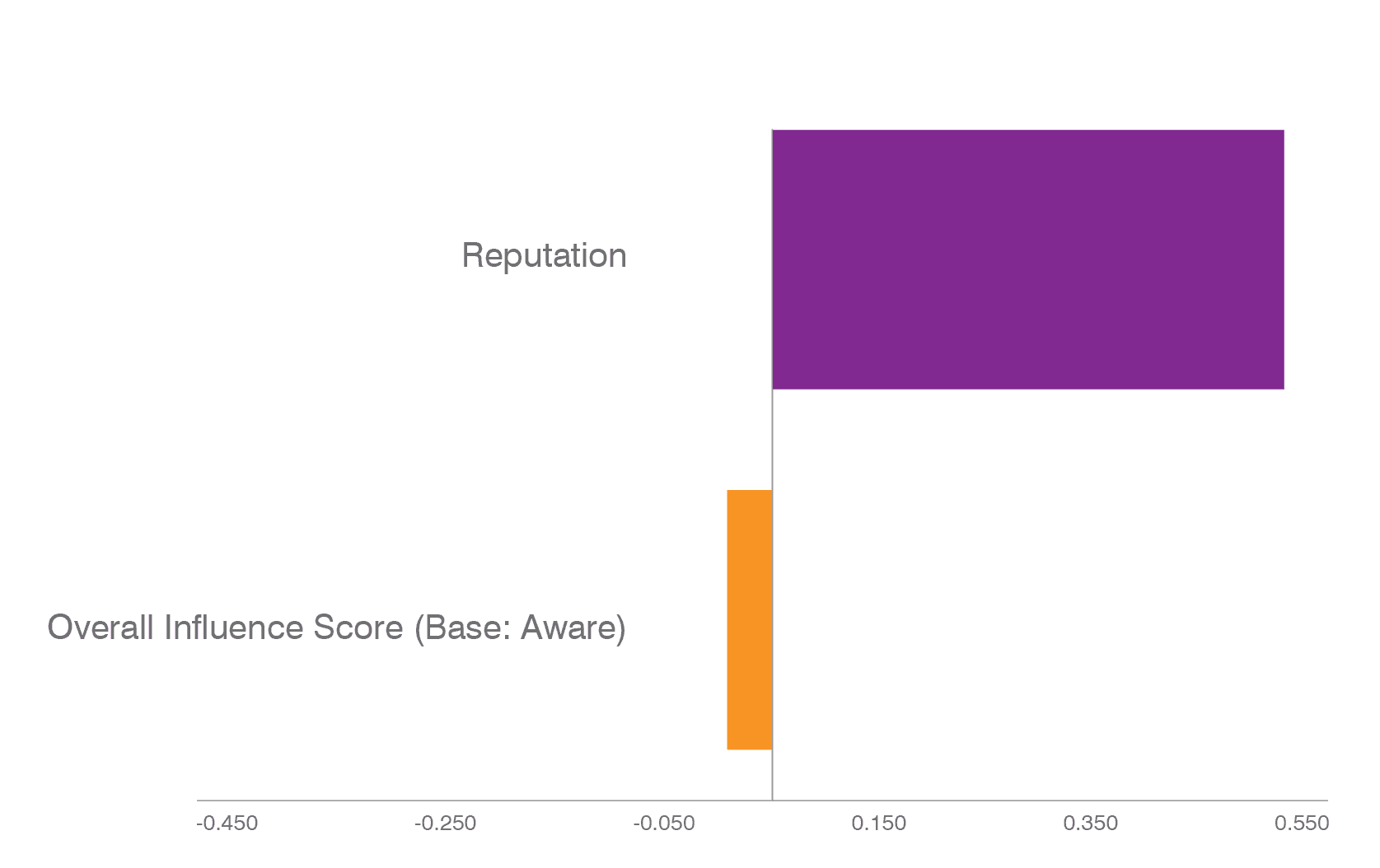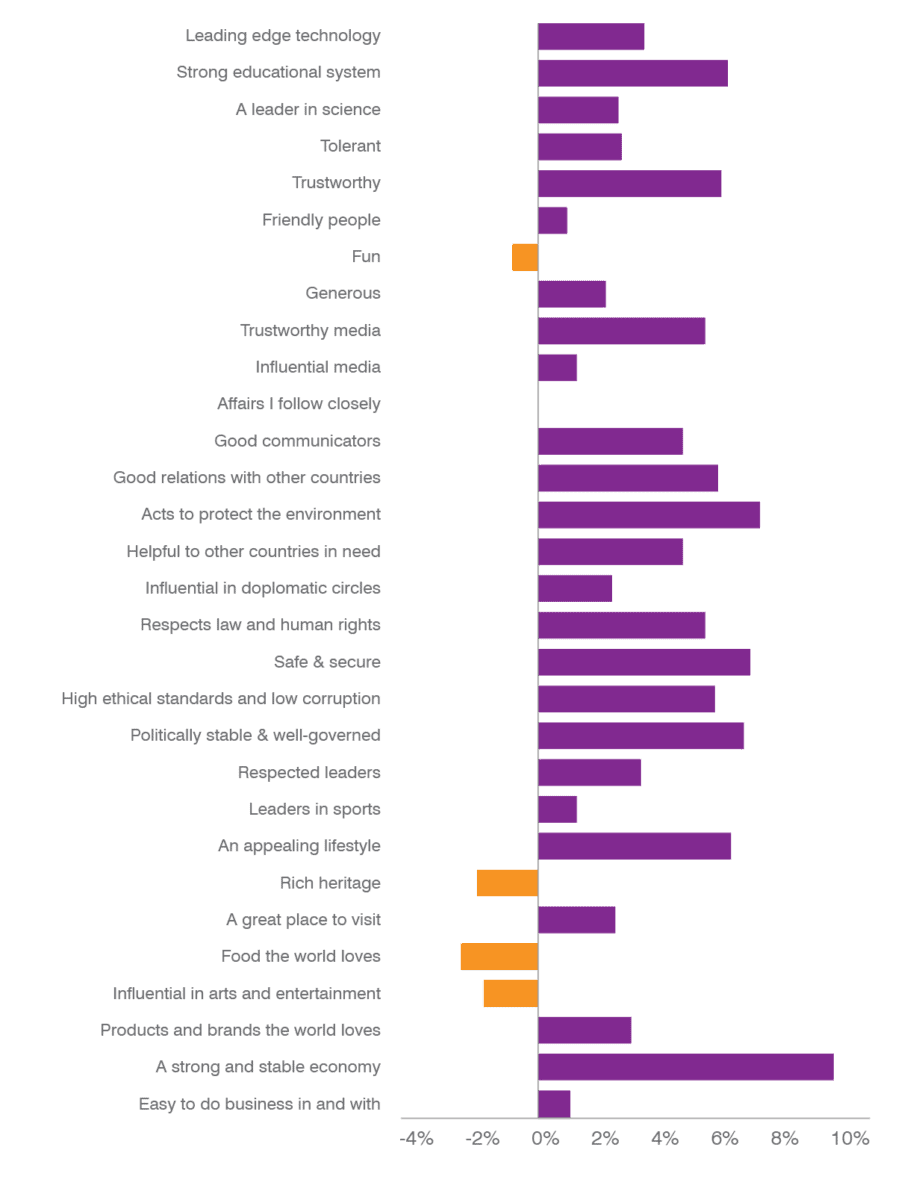The pandemic has reignited a long running debate: who make better leaders in the current environment? Women or men?
A lot has been written about how female leaders have managed the pandemic better than their male counterparts.
Most analyses have focused on proving this link, without trying to identify the causes of the difference in outcomes and their implication for the future of political leadership. Given our extensive Global Soft Power Index database, we set out to answer what we consider the most important question: why do female leaders seem to be more successful in facing the pandemic?
To conduct this analysis, we identified all the female-led countries in our database. Only eight countries are led by women: Germany, Switzerland, Belgium, Denmark, Norway, New Zealand, Bangladesh, and Myanmar. We then identified the pillars and attributes in which these countries scored higher than average, as well as their impact on the country´s overall influence.
We then conducted an extensive review of the literature on the traits and impact of female leadership, to further investigate these results.
This article relates to the findings of Brand Finance's Global Soft Power Index. See the full index here.
“The Future is Female”
One of the most popular slogans used by feminist leaders is “the future is female”. While this phrase originated in New York in the 70s, it has since been revived by activists, influencers, and political leaders alike. Musician and activist, Madame Gandhi, recently released a song titled after the slogan, and Hillary Clinton famously declared that “the future is female” in her 2017 Makers Conference.
Despite the volume of conversation around the subject, there are only 24 female CEOs within Fortune 500 companies, which is down from 32 the previous year.
Out of these women, only four feature in our ranking of the top 100 brand guardians (CEOs of the world's most valuable brands).
See the full Brand Guardian ranking here: 2020 Brand Guardianship Index.
That being said, the world’s best brand guardian was Marillyn Hewson, CEO of Lockheed Martin. Also generally, the quality of female leadership is also very high. On average the 4 female CEOs in the ranking perform much better on ‘Net Positive Coverage’ and ‘Average Dividends per Share’, with a lead of 3.5 points out of 10 ahead of their male counterparts.
The numbers don't lie. Women are still drastically underrepresented in leadership positions. The sad truth is a phrase coined in the 70s - about the future - still applies fifty years later.
So when we are analysing female leadership, we can not forget that we are still operating within a small sample. Though we live in the 'future', we are still many years away from leadership roles adequately reflecting the diversity of western democratic society.
Reviewing the Literature on Female Leadership
From our own analysis, it is clear that women leaders, although far outnumbered by their male counterparts are linked with higher performance. However, this is only one study of many.
Our review of existing literature on female leadership found that there are three types of research that are typically conducted which seek to prove:
- The link between female leadership and successful financial outcomes.
- That traits of female leadership lead to better results.
- That female leadership style (often coined as “compassionate leadership” or “cautious leadership”) and traits are preferred by the general population
The link between female leadership and successful financial outcomes
In 2018, Nordea conducted a study to discover if diversity paid off for shareholders. While it could not prove the link between a larger share of female leaders and higher returns, it showed a correlation with lower volatility in returns 1.
In 2016, MSCI found that, in the period 2011-2014, companies with three or more women on the board had higher earnings per share and return on equity, compared with companies with zero female directors in the same period.
Goldman Sachs has recently analysed 496 large-cap US equity funds and found that female-managed funds outperformed their male counterparts amid the coronavirus-related market swings2.
Traits of female leadership lead to better results
In 2015, Corinne Post conducted a study that showed that female-led teams scored higher on cohesion, cooperative learning, participative communication, and that the female leadership advantage widened when the coordination requirements were higher 3.
Female leadership styles and traits are preferred by the general population
Within this third group, we found a myriad of studies, so we will just focus on the results of a few. A recent study by Deloitte in 2018 states that “modern leaders should look to balance hard and soft power traits.” Being communicative, flexible, and patient – soft power traits which are usually considered feminine – were among the five most important factors for strong leadership. 4
Another study conducted by Harris Poll in 2018 showed that half of Americans would prefer to work for a company run by a female leader5.
All the studies discussed above show evidence for the link between female leadership or feminine leadership traits, financial impact, and social preference.
Considering this, the questions are: which traits define a feminine leadership style? How do women tend to lead? What can we classify as attributes typically feminine or masculine? To answer these questions, we conducted further research.
Feminine vs. Masculine Traits and Leadership
John Gerzema and Michael D´Antonio researched the subject by surveying 64,000 people in 13 countries 6. Their objective was to discover “if – due to the economy, technology, generational influences, globalization, and other factors - people, in general, might be placing more value on the feminine side of human nature.” Some of their key findings support that hypothesis:
- 66% of those surveyed thought that “the world would be a better place if men thought more like women.”
- 57% of those surveyed were “dissatisfied with the conduct of men in their country.”
As part of the same work, they asked half of their sample to classify 125 different human traits as either masculine, feminine, or neutral. Attributes like “rugged,” “dominant,” “aggressive,” “selfish,” and “hard-working” were classified as masculine, while “selfess,” “patient,” “sensitive,” “sincere,” “nurturing,” and “trustworthy,” as feminine.
Then, they presented the same list of attributes to the other half of their sample and asked them to rate the importance of those traits to leadership and success. Comparing the results from both samples, they determined which feminine attributes would make up an ideal modern leader (see Figure 1).

What the data proves is that the definition of leadership is changing and masculine traits like aggression and control are becoming less effective than feminine attributes like collaboration and flexibility. The authors conclude that in “a world that´s increasingly social, interdependent and transparent, (...) feminine values are ascendant.”
Now, our question is: are these results from the corporate world equally valid in the world of public diplomacy and geopolitics? To answer this question, we will explore the results of the Brand Finance Global Soft Power Index.
Evidence from the Global Soft Power Index
The concept of soft power has become increasingly relevant in the 21st century. Professor Joseph Nye (2004) 7 defined soft power as “the ability to influence the preferences and behaviours of various actors through attraction rather than coercion.”
We released the Global Soft Power Index in February 2020 in an effort to measure the soft power of nations, its levers, and impact on prosperity. The study covered a sample of over 55,000 respondents in 100 countries, including specialists and the general public. The study incorporates a broad range of measures, which in combination provide a balanced and holistic assessment of nations’ presence, reputation, and impact on the world stage. These include:
- Awareness and Familiarity: nation brands which people know, and have mental availability of, have greater soft power
- Overall Influence: the degree to which a nation is seen to have influence in the respondent’s country as well as on the world’s stage
- Overall Reputation: is this nation deemed to have a strong and positive reputation globally?
- Performance on the 7 Soft Power Pillars (Business & Trade, Governance, International Relations, Culture & Heritage, Media & Communication, Education & Science, People & Values). Figure 2 depicts each pillar and the variables measured in each one of them.

Although the nations governed by male leaders, on average, have more overall influence, they are perceived as having a significantly higher negative influence, on average, than the female-led nations. The female-led nations, on average, have a better reputation and a higher net positive influence (see Figure 3). Female-led nations outperform in Governance, International Relations, and Business & Trade (Figure 4).


Out of the attributes we measure in our Global Soft Power Index, on average, the nations led by female leaders outperform the nations led by men in 26 of them, and only underperform in 9 (see Figure 4).
They are perceived significantly better in the following attributes:
- A strong and stable economy
- Acts to protect the environment
- Good relations with other countries
- Safe and secure
- An appealing lifestyle
- Politically stable and well-governed
- Trustworthy
- Strong educational system
- High ethical standards and low corruption
Most of these attributes relate to three key themes: stability, safety and security, and trust and ethics, and many to the values classified as “feminine” in the work of Gerzema and D´Antonio.
In his book, “Leaders Eat Last” 9, Simon Sinek described how strong leaders make people feel secure. This is probably one of the key common traits that has been identified in female leaders during the pandemic: clear communication and decisive action which makes citizens feel secure.
Most countries led by women performed well in the following traits even before the pandemic: protection, stability, security, and trustworthiness. If anything, the need for increased cooperation and multilateralism brought by the pandemic has further highlighted the importance of a leadership style based on these values.
Within this context, it is not surprising that Germans call Chancellor Merkel the nation’s “Mutti” (Mummy). This just exemplifies how, in an increasingly volatile world, leadership is about cooperation, protection, and safety – values in which female-led nations outperform male-led ones.
Hard Power and Economic Power
In addition, when comparing how nations perform on Hard Power and Economic Power, an interesting pattern emerges (See Figure 5).

While both female-led and male-led nations perform similarly on Economic Power, the divergence is evident when comparing Hard and Soft Power scores.
“One of the criticisms I’ve faced over the years is that I’m not aggressive enough or assertive enough or maybe somehow because I’m empathetic, it means I’m weak. I totally rebel against that. I refuse to believe that you cannot be both compassionate and strong”.
Jacinda Ardern, Prime Minister, New Zealand
Male-led nations outperform on Hard Power while female-led nations lead on Soft Power. As Soft Power is seen as an increasingly important tool for success, nations that can successfully leverage this are set to thrive across a variety of areas.
Female leadership styles appear to be well-placed to tackle changes in the future. The greatest challenges of our time, including the coronavirus pandemic, climate change, and social conflict and polarisation require co-operation, stability, and safety and security – attributes where female-led nations outperform those run by men.
Brand initiatives to close the gender gap
Can we prove that these results are completely dependent on female influence? The short answer is no.
A key outlying question is whether there is a correlation between the duration in office of female leaders and these results, or whether they have been forged before their mandate and female leaders have accelerated them.
A lot of the outcomes we discussed are forged in the long run. We also know that, historically, there have been female leaders with extraordinary negative influence on their nations, kingdoms, or cities.
“No company that wants to grow can give up talent, and women represent 50%.”
Rami Aboukhair, CEO Santander Spain
Our analysis points to leadership styles based on attributes that have been historically recognised as more associated with females. It is possible that most women-led nations are diverse and inclusive societies. These cultures tend to be more respectful of differences and provide opportunities and support for a diverse pool of talent. This can explain the representation of women in positions of power, but also, the maturity of that nation in many other pillars of soft power.
This might be the main explanatory variable behind the disparity in results for female-led nations: inclusion. As Rami Aboukhair, CEO of Santander Spain, puts it: “No company that wants to grow can give up talent, and women represent 50%.”
We have conducted a vast analysis of the impact of diversity and inclusion on brand strength, finding a significant positive link.
If female talent is so important to grow, corporations need to take action to ensure female representation at the top. These actions can be categorised in three clusters:
- Education and Training
- Policies and Standards
- Evaluation and Reporting
Education and Training
How can the organization support female leaders’ development? Through sponsorship, mentoring, coaching, specific leadership skills training and networks. IBM is a great example of a company that provides all these platforms for female leaders. In their EMEA division they have created a “Women in Tech” mentorship program as well as an open network called “Inspired by Women” that raises awareness about unconscious biases or specific obstacles in female development and how to tackle these challenges. These initiatives not only support individual development but also enable connections necessary to propel careers forward.
Policies and Standards
Flexibility in terms of work schedules extended leave, and working from home policies are all key for many working mothers and instrumental in avoiding losing talented female leaders.
Evaluation and Reporting:
All the above sounds good, but it is also imperative to prove the impact it has in terms of employee satisfaction, a positive climate, and retention. Not only that, but ideally, it should be linked to business and brand value creation. Measuring the impact of D&I initiatives oriented to leverage female talent is essential to secure continued investment.
Conclusions
Our database analysis shows that nations led by females outperform, on average, their male-led counterparts in net positive influence, reputation, and most attributes under the seven pillars of soft power, but particularly those related to safety and security, a stable economy, trustworthiness, and cooperation (good relations with other countries).
Although this is based on a relatively small sample, and that these results can be also explained by many other factors, analysing the literature around traits and impact of female leadership allows us to infer that feminine values definitely make a positive impact also on a geopolitical level.
This is not to say female leaders are free of mistakes. As Joseph Nye explained in an interview with David Haigh in September 2020: “Women are human too and they make mistakes”. But the female leadership style is more strongly correlated to soft power attributes, rather than hard power ones.
On a corporate and geopolitical level, these attributes will be key to build positive influence and reputation going forward. To ensure we have more of this type of leadership going forward, public and private organizations need to focus on diversity training, standards, and measurement.
Jacinda Ardern, Prime Minister of New Zealand, and one of the leaders praised for her management of the pandemic, recently said: “One of the criticisms I’ve faced over the years is that I’m not aggressive enough or assertive enough or maybe somehow because I’m empathetic, it means I’m weak. I totally rebel against that. I refuse to believe that you cannot be both compassionate and strong”.
This underlines the importance of compassionate leadership in an environment that becomes increasingly volatile. We are convinced that a leadership style based on traditionally feminine traits will have a positive impact in a world that is plagued by polarisation and conflict, that requires now more than ever: multilateralism, collaboration, and compassion.
This article relates to the findings of Brand Finance's Global Soft Power Index.
- Nordea (2018), “Investing in female leaders makes business sense” https://www.nordea.com/en/press-and-news/news-and-press-releases/news-group/2018/investing_in_female_leaders_makes_business_sense.html[↩]
- Flood, C. (2020), “Female-managed US funds outperform all-male rivals”. https://www.ft.com/content/021a1b60-a5fa-42ad-83b4-482268cac7ac[↩]
- Post, C. (2015), “When is female leadership an advantage? Coordination requirements, team cohesion, and team interaction norms,” Journal of Organizational Behaviour[↩]
- Deloitte (2018), “What’s the future of leadership?”. https://www.deloittedigital.com/us/en/blog-list/2018/what_s-the-future-of-leadership--read-about-our-new-research.html[↩]
- Berlin, C. (2018), “Research Reveals Half of Americans Want to Work for a Female Leader” https://www.globenewswire.com/news-release/2018/01/25/1305181/0/en/Research-Reveals-Half-of-Americans-Want-to-Work-for-a-Female-Leader.html[↩]
- Gerzema, J., and D´Antonio, M. (2013), “The Athena Doctrine: How women (and the men who think like them) will rule the future,” Jossey-Bass, San Francisco, 1st Edition [↩]
- Nye, J. (2004) “Soft Power: The Means to Success in World Politics,” Public Affairs, NY, New York[↩]
- Global Soft Power Index 2020, Brand Finance[↩][↩]
- Leaders Eat Last, S. Sinek[↩]
- Global Fire Power, IMF[↩]
